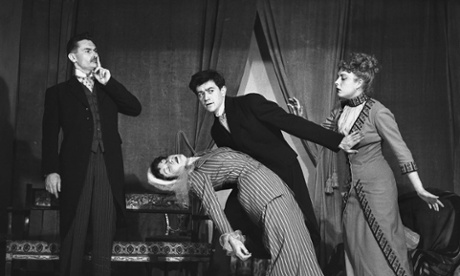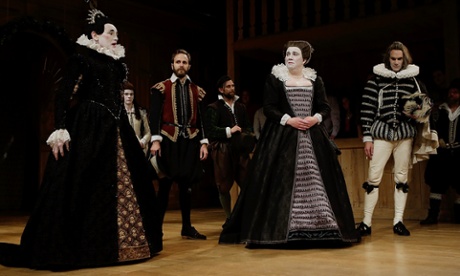Carol Morley’s recent film, The Falling, brings into dreamy focus a phenomenon with a long literary history. Unlike a straight faint, the literary swoon is never just a medical matter – it’s often the product of overwhelming feeling or the return of something repressed. Swooning has long been used by writers to dramatise moments of crisis, ecstasy and confusion, and the failure of language to express these extremes. It has a strong association with the unnerving and the uncanny, with sickness and dying, femininity, queer sexuality, moments of political instability. A swoon might be an act of resistance, a dramatic rejection of a culture’s language – but it can also reinforce stereotypes, such as the sickly, swooning, hysterical woman. It’s powerfully ambivalent, and often found in the work of writers who try to imagine a different kind of world and for whom coming round from a swoon signals a new way of being conscious.
1. The Virgin Mary
The Swoon of the Virgin was a popular subject in medieval art, with influential artists depicting Mary fainting and weeping at the foot of the cross. Her sympathetic swoon signals the strength of her suffering: she shares in the productive pain of the Passion, which will give birth to the church. In one early literary swoon (The Life of Mary Magdalen, c1290), a labouring woman is overcome by birth pangs and is eventually woken from apparent death by “Saint Marie”. These maternal swoons symbolise the power of suffering to produce new spiritual life.
2. Chaucer’s Troilus and Criseyde
In medieval romances, knights swoon just as frequently as ladies. In Chaucer’s Troilus and Criseyde (c1380), the hero and heroine both swoon at key moments, demonstrating that passion brings them close to death. Troilus swoons at the mid-point of the poem, allowing Chaucer to produce an intricate description of physiology and passion: his heart shuts down and his vital spirits contract; all feeling flees before he swoons. Falling in love is a risky business and its danger is expressed through the swoon.
3. Shakespeare’s Hero
Shakespeare’s tragic heroes swoon when their self-governance dissolves, foreshadowing disturbances in the body politic. But it is Hero in Much Ado About Nothing (1598) who sustains the longest and most remarkable swoon on the Shakespearean stage: accused of unfaithfulness, she falls, leaving the other characters to debate over her prostrate body. Some interpret the swoon as guilt (she is “fall’n / Into a pit of ink, that the wide sea / Hath drops too few to wash her clean again”), others as proof of her innocence. Hero’s swoon is a rejection of men’s lies and her silent, physical response highlights the possible treachery of language.
4. Samuel Richardson’s Clarissa
Swooning emerges in the popular novels of the 18th century as a particularly feminine habit. In his 1748 novel Richardson deploys a series of faints and swoons to describe the decline of his ill-fated heroine, the eponymous Clarissa, who is drugged and raped. Clarissa’s swoons demonstrate her feminine sensitivity, but they also iconise her vulnerability: the swoon is used to describe the downward trajectory of the fallen woman in many novels of this period, producing an uneasy mix of sympathy and voyeurism.
5. Jane Austen’s Musgrove sisters
“Beware of swoons … Run mad as often as you chuse; but do not faint,” the 14-year-old Austen cautions an early heroine. She retains this swoon scepticism in her mature work: in Persuasion (1818), Louisa Musgrove develops the habit of throwing herself into her beau’s arms from various heights and manages to knock herself out cold on the pavement. Her sister sinks into a sympathetic swoon and both are “insensible”. News spreads to “the workmen and boatmen about the Cobb, and many were collected … to enjoy the sight of a dead young lady, nay, two dead young ladies, for it proved twice as fine as the first report”. Austen satirises the morbid pleasure that swooning allows the male viewer, as well as the hysterical feminine performances that have produced it.
6. Charles Dickens’s Mrs Gamp
In Bleak House (1852–53), Dickens uses the swoon to signal the power of an unspeakable past: Lady Dedlock swoons at the first hint of her hidden affair and child. But Dickens also ridicules characters who swoon as part of a social performance. Mrs Gamp (Martin Chuzzlewit, 1843–44) wilts on demand, “perform[ing] swoons of different sorts, upon a moderate notice, as Mr Mould did Funerals”. Mrs Gamp’s faints are a feint of feminine sensitivity, a cynical means of social manipulation.
7. Elizabeth Barrett Browning’s Aurora Leigh
In her ground-breaking verse novel, Aurora Leigh (1856), Barrett Browning uses the swoon to figure the transformation of a woman into a poet: “I did not die. But slowly, as one in a swoon / To whom life creeps back in the form of death, /… I woke, rose up.” Barrett Browning alights on the early religious and maternal significance of the swoon, using it to depict spiritual rebirth through death: waking from the swoon means waking into a radically reconfigured world, a world where women might reject Victorian constraints and follow the call to write.
8. Bram Stoker’s Jonathan Harker
The gothic, with all its buried secrets and untimely returns, has a strong tradition of swooning, and the figure of the vampire is particularly associated with immobility: the vampire mesmerises his victims into a semi-pleasurable, half-conscious state of semi-consciousness. In Stoker’s Dracula (1897), Harker is overwhelmed in Dracula’s castle – “the horror overcame me, and I sank down unconscious” – leaving the Count to carry him to bed. The lunatic Renfield, fawning on his “Master”, “falls” into paroxysms, and “swoon[s] into a sort of coma”. Passive, swoony masculine states are a source of terror in this Victorian novel, which nevertheless betrays a fascination with the pleasures of erotic immobility.
9. James Joyce’s Stephen Dedalus
In A Portrait of the Artist as a Young Man (1916), Stephen Dedalus’s coming of age is described as his soul, “swooning into some new world, fantastic, dim, uncertain”. Joyce repeatedly describes characters emerging into a significantly altered world following a swoony epiphany, as in the memorable, alliterative final line of “The Dead” in Dubliners (1914): “His soul swooned slowly as he heard the snow falling faintly …. upon all the living and the dead.” The soul-swoon is used by Joyce to represent the transformation of the person into the poet, the ordinary into the new and strange, and the living into communion with the dead.
10. Angela Carter’s The Bloody Chamber
EL James’s “red room of pain” and fainting heroine were anticipated (and surpassed) by Angela’s Carter’s “The Bloody Chamber” (1979), a reworking of the Bluebeard tale. Carter’s poor, virginal narrator marries a marquis, entering a world of obscene wealth. She discovers a hoarde of murdered wives hidden in her husband’s pile, but her “nerves of steel” mean that she swoons only once: she stumbles across a blind boy, a gentle piano-tuner and, “after the dreadful revelation of that bloody chamber, it was his tender look that made me faint”. Carter’s swoon becomes a hopeful turning point, opening up the possibility that violence might be transformed into tenderness.
• Naomi Booth’s debut novella, The Lost Art of Sinking, is published by Penned in the Margins.










